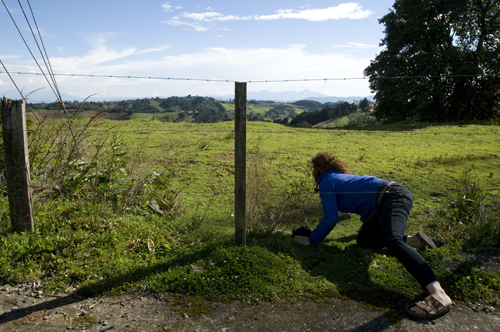The post A Voyage To Costa Rica’s Underwater Serengeti appeared first on The Expeditioner Travel Site.
]]>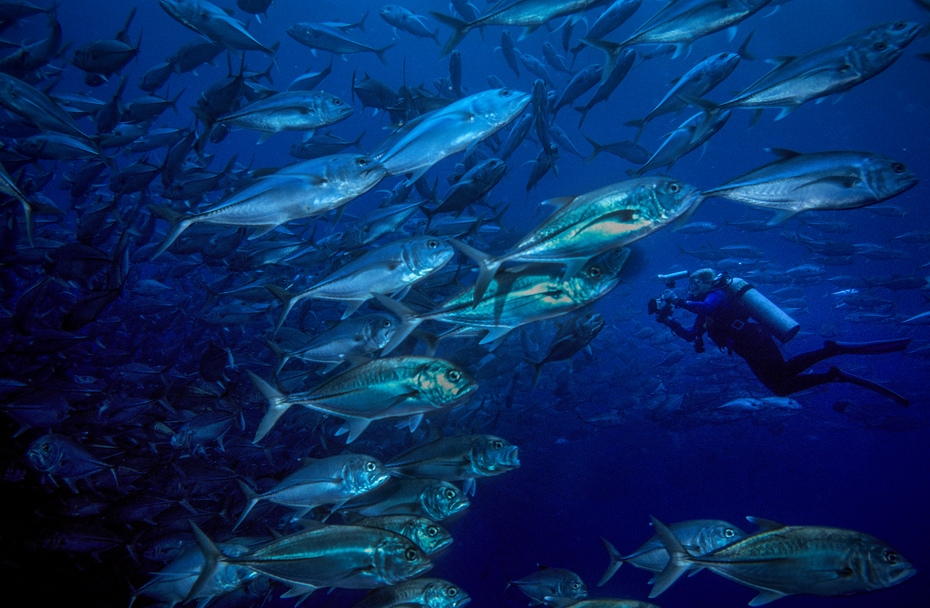
330 miles west, or a day and half in boat time, is Cocos Island, an uninhabited island officially part of Costa Rica that is considered to be one of the world’s best locations for scuba diving due to the massive amount of sealife that call the island’s nearby water home (hence the nickname “underwater Serengeti”). Much like the nearby Galapagos, the islands were formed as part of volcanic activity, and the perimeter of the island is made up of 300-foot-high cliffs. And as if the island couldn’t be any more Bond-villain-like, there are lots of sharks there. Lots and lots of sharks.
As the San Francisco Chronicle recently explored during a diving trip there, the island is home to a hammerhead shark “cleaning station,” a location where the oddly shaped sharks congregate and enjoy a free spa session from schools of barber fish who like to munch on the parasites found on the shark’s skin (in turn, the sharks enjoy better health, the ability to swim faster and a shiny glow to attract members of the opposite sex).
Don’t be surprised to see great whites, whale sharks, Galapagos sharks and blacktips sharks there as well, along with the usual roster of underwater sealife such as guinea fowl puffer fish, Chinese trumpetfish, whitetip reef sharks, frogfish, snappers, dolphins and even California sea lions.
The tough part about this trip is the cost. You’re going to need a boat, and not just any boat, but one that can schelp you and a bunch of scuba gear, guides and food way out into the middle of the ocean. In other words, you’re looking at dishing out $4,000 minimum just to get out there and dive. However, when you get back, you can tell people you saw a great white shark swim through a hammerhead cleaning station while you floated dozens of feet below them. So, totally worth the cost.
For a staring point in your research, check out Undersea Hunter’s site, which provides information on tours to the island.
By Matt Stabile
[Cocos Jacks by Barry Peters/Flickr]

ABOUT THE AUTHOR
 Matt Stabile is the founder and Editor-in-Chief of TheExpeditioner.com. You can read his writings, watch his travel videos, purchase the book he co-edited or contact him via email at any time at TheExpeditioner.com. (@TheExpeditioner)
Matt Stabile is the founder and Editor-in-Chief of TheExpeditioner.com. You can read his writings, watch his travel videos, purchase the book he co-edited or contact him via email at any time at TheExpeditioner.com. (@TheExpeditioner)
The post A Voyage To Costa Rica’s Underwater Serengeti appeared first on The Expeditioner Travel Site.
]]>The post A Cheap Bastard’s Guide To Traveling appeared first on The Expeditioner Travel Site.
]]>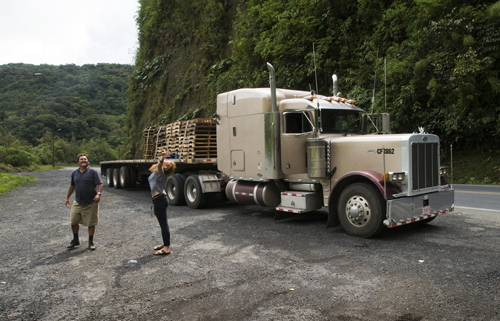
Pan-American Transmissions Part 3: Costa Rica
“Pan-American Transmissions” is a travel series from Special Contributor Diego Cupolo as he travels south from Nicaragua to Argentina. He has few plans, a $10-a-day budget and one flute-playing gypsy companion. Check back as new dispatches are posted from the road.
They warned us about Costa Rica.
Young travelers, broke travelers, I-do-this-for-a-living travelers — they all sped through it. They wanted nothing to do with it. For them, Costa Rica was a blank spot between Nicaragua and Panama where everything costs more and every place is packed with North American families peeing in small swimming pools in front of grand, beautiful oceans.
“The Switzerland of Central America” they called it.
Sure, Costa Rica is significantly more expensive than its neighbors, but this alone is no reason to skip a country so full of lush biodiversity and untamed landscapes. In fact, price tags are no reason to skip any country.
As I wrote in my last post, you don’t need money to travel. Creativity and discipline are much more valuable when on the road.
Ania and I passed a few weeks exploring Costa Rica’s cloud forests and Caribbean beaches. Even with our small budget, we found it relatively manageable and thoroughly enjoyable. Using a myriad of patented, tried-and-tested techniques we spent no more than $8 a day each.
The following is a cheap bastard’s guide to traveling. While each point is taken from our time in Costa Rica, these “strategies” work in most countries and should help budget travelers survive anywhere in the world.
When done right, traveling can be cheaper than staying at home. Here’s how.
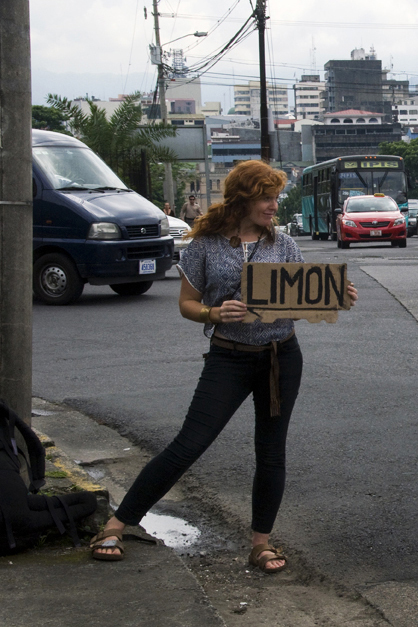 Hitchhike
Hitchhike
First for a reason. Hitchhiking is not only a free ride, but one of the best ways to meet locals. You never know where a good conversation will take you. Truckers are usually the most helpful and also the most lonely. (The two probably go together.) They drive long distances, like to talk and know all the best, cheapest roadside eateries.
Don’t feel safe riding with strangers? Look the driver in the eyes before jumping on board. Evil is easy to spot. Drug addicts, even easier. If it doesn’t feel right, it probably isn’t. Just remember, most people don’t drive around looking for someone to kill or rob. Most people, unlike what you see in movies, are amazingly nice and incredibly humane.
Bring a tent
It’s a good idea to have a backup home in your bag. Packing a lightweight tent can save money and reduce stress. No matter what happens, you’ll have shelter. Even better, hostels with backyards usually let travelers set up camp at a fraction of the cost for a room.
Ania and I usually pitch our tent outside hostels, but the beaches near Puerto Viejo seemed safe enough so we decided to camp on the white sand under the bright stars. Free, marvelous and refreshing after a night in Rocking J’s obnoxious warehouse hostel (avoid at all costs).
Lonely Planet, Schmonely Schmanet
Of course, this popular backpacker’s guide can be helpful, but Lonely Planet is not God. It does not see all nor explain all and, as result, can affect travelers’ experiences, for the worse, when they follow it too closely.
This is especially true for accommodation. There’s always cheaper options than the ones in the guide. When a hotel is listed in Lonely Planet, its price goes up. This is a fact. Instead, consult taxi drivers, traveling artisans or, even better, local hookers. They might laugh at first, but they’ll point you towards the cheapest (and probably most exciting) place in town.
Couchsurfing
It’s like Facebook, but useful. Couchsurfing is one of the best resources for travelers on the Internet. It lets people host and be hosted by members around the globe, and it’s free, easy and safe thanks to a internal review system.
Couchsurfing not only allows the unique opportunity to meet and temporarily live with locals, but it’s extremely helpful in urban areas. Knowing someone in a big town makes the difference between another confusing city experience and being invited to the neighbor’s uncle’s all-night pig roast.
Ania and I, emaciated from parasites in Nicaragua, were brought back to health by the generous meals of a generous couchsurfing family in Naranjo. Thanks again Andrés!
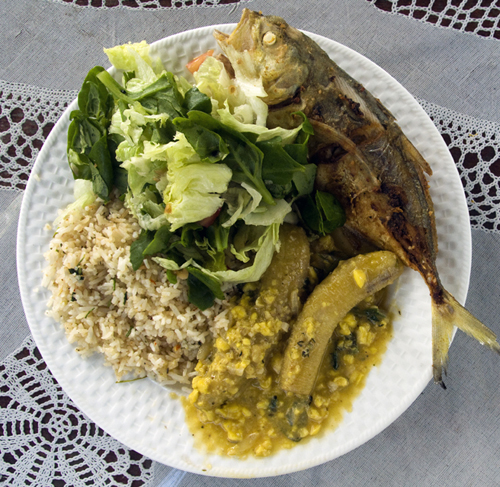 Cook!
Cook!
Street carts, farms, dumpster-diving, supermarkets, street markets. Food: You need it every day and there’s a thousand ways to approach the matter. While restaurants can be the easiest and fastest option, their prices and portions can vary drastically. Sometimes you get a deal, other times you get undigestible slop. The most reliable, cheapest and healthiest way fill your stomach is to cook.
Try staying in places with kitchens as much as possible. Rice, pasta, beans, potatoes, eggs — they’re all filling and they’re all cheap. A personal favorite is oatmeal. It’s lightweight, wholesome, can be eaten raw or cooked, and it’s delicious when mixed with local fruits and milk.
On the subject of “local,” eat what the locals eat and what grows locally if you want to save money. Costa Rica was banana and pineapple land so I mixed bananas and pineapples with my oatmeal every morning. It’s that simple.
Also, keeping salt and few spices handy can turn a bland dish into a fine dining experience.
Enter Parks Through the Back Door
Some might say this is wrong, but since when did nature have a price? Putting up a fence and demanding entrance fees is usually a scam. I’d be happy to pay if the money went towards park maintenance, but that rarely happens.
Skip entrance fees by finding alternative entrances.
In Cahuita, Ania and I asked around and found there were two entrances to the national park. One entrance was for tourists and charged $10 a person, the other was for locals where you were simply asked for “donations.” We paid a dollar each and spent the rest of the day watching howling monkeys and sloths climb through palm trees over pristine caribbean waters.
Work, Exchange, Sell, Juggle
Yes, work. Travelers can usually make arrangements with local business owners to work a little in exchange for free room and board. The easiest places to do this are hostels, farms and boats, but the possibilities are endless. Any place that keeps money out of the equation is a good place.
Not to mention, the best way to know a country and its people is to settle down and work for a while.
For the independently minded, starting your own business can be surprisingly easy on the road. Just ask a fellow street vendor who is often from elsewhere in the region. They can be found on sidewalks throughout Central and South America selling jewelry, crafts and magic stones. They do it because it works. People love to buy stuff from the streets and this addiction can pay for your travels — sometimes for years.
Also try juggling things, riding unicycles, spitting fire, playing instruments or selling food — use your imagination. As capitalism has proven over and over again, money can be made from anything. I met a French couple that paid for their travels by selling colored pipe cleaners bent in the shape of little spiders.
Hell, you could even become a travel writer and send rambling nonsense to magazines and web sites if you feel like it.
Final points
- Go slow.
- Always ask a local.
- Buses cost more in bus stations — catch them on the road.
- Always bargain.
- Don’t pay the first price they give you, but don’t be an asshole.
- Put the money in their hand to put a quick end to negotiations.
- Travel in small groups to split rooms and expenses.
- Nature is free.
- Walking is free.
- Drink on an empty stomach.
- And, lastly, carry soap and rope to wash and dry your clothes you damn snob.
By Diego Cupolo
Read Part One of Pan-American Transmissions (Northern Nicaragua) here and Part Two (Southern Nicaragua: Bargain Paradise) here.
Coming soon from Pan-American Transmissions: Panama City Booming.

About the Author
 Diego Cupolo is a freelance photojournalist currently on the road to Tierra del Fuego. Most recently he served as Associate Editor for BushwickBK.com, an online newspaper in Brooklyn, and his work has appeared in The New Yorker, The Atlantic, The Star-Ledger, The Australian Times, Discover Magazine and many other publications. View more of his work at DiegoCupolo.com.
Diego Cupolo is a freelance photojournalist currently on the road to Tierra del Fuego. Most recently he served as Associate Editor for BushwickBK.com, an online newspaper in Brooklyn, and his work has appeared in The New Yorker, The Atlantic, The Star-Ledger, The Australian Times, Discover Magazine and many other publications. View more of his work at DiegoCupolo.com.
The post A Cheap Bastard’s Guide To Traveling appeared first on The Expeditioner Travel Site.
]]>The post The Visa Run Diaries appeared first on The Expeditioner Travel Site.
]]>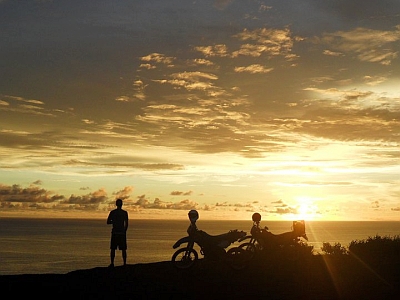
What would Che say?
Perspiring at a rate that suggests total disintegration is imminent, the police officer wiped another sweat globule from his a forehead.
“Where are your papers?” he asks.
With nostrils floating in a sea of rubbery flesh, shirt buttons straining against a bloated paunch, the overall impression is one that makes me think back to Mr Ward and his production of Animal Farm in sixth grade where my drama teacher found it difficult to transform human children into convincing representations of authoritarian Orwellian livestock. This guy would have been an absolute inspiration.
“Your papers!'”, he insists again.
Silence. We look at each other with expressions that we hope suggest “innocent tourists harmless and confused in a foreign land,” but it’s a card we’ve been playing for about six or seven minutes now and pig-boy is getting agitated. Itching for a bribe, he and his less mean colleague — the universally prerequisite good-cop — nabbed us as we were traveling helmet-less on our way to find a watering hole.
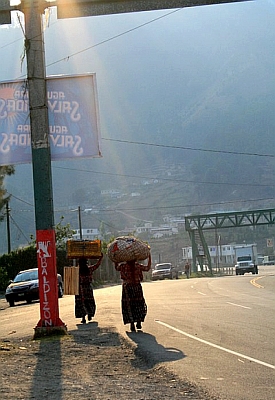 We’d just entered Nicaragua from Costa Rica and had, evidently prematurely, been reveling in the freedom that being back in “the real Central America” afforded us. Our state of lawless abandon having betrayed us, we were now trying to avoid paying a penalty to the Tweedle-twins estranged third sibling. Even more frustratingly, as we stood defending our honor and our wallets on the dusty pavement, great swaths of the population were passing by entirely helmet-free, flagrantly enjoying the sensation of the wind through their hair and warranting no attention from our diligent crime-fighting duo. Fundamentally, we looked like we had a lot of cash and little idea.
We’d just entered Nicaragua from Costa Rica and had, evidently prematurely, been reveling in the freedom that being back in “the real Central America” afforded us. Our state of lawless abandon having betrayed us, we were now trying to avoid paying a penalty to the Tweedle-twins estranged third sibling. Even more frustratingly, as we stood defending our honor and our wallets on the dusty pavement, great swaths of the population were passing by entirely helmet-free, flagrantly enjoying the sensation of the wind through their hair and warranting no attention from our diligent crime-fighting duo. Fundamentally, we looked like we had a lot of cash and little idea.
Presumably then, apart from getting hideously mauled in a traffic accident, it is because of situations like this that moms and dads are never going to be thrilled about you riding across five Central American countries on the back of a motorcycle with a cigarette in your hand and a bad man between your legs. Even if, in actual fact, you successfully negotiate brushes with the law, the man between your legs is actually very nice and the logistics of sucking on a cigarette while riding a bike at dangerously fast speeds defeat the intention. Trips such as this one remain something I endeavor to keep under the parental radar.
The purpose of the expedition was basically a visa run. In Guatemala, once you have been in the country for six months, it is compulsory for you to leave in order to renew your visa. Thanks to a rather annoying loophole where four of the Central American countries got together and decided to make life ”easier,” you cannot cross into one of Guate’s immediate neighbors in order to do so. Therefore, when I found out that my two friends, Matt and Chris, were heading down to Costa Rica for an Ultimate Frisbee competition (which is basically Quidditch for people who aren’t wizards), and would be riding back up through Nicaragua, El Salvador and Honduras with space for a passenger, I seized the opportunity.
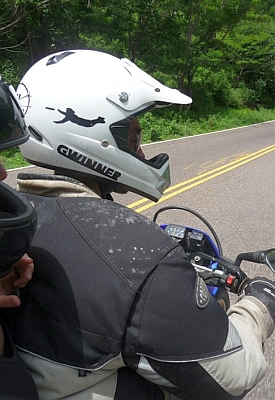 My journey down to meet the boys involved a series of buses, a night in San Salvador with the most depressing human being ever to walk the planet (who hailed, conversationally, from Texas and had a face that denied anatomical convention, in a bad way), two road blocks and a rather embarrassing incident where I was asked to unpack my underwear onto the side of a Honduran highway. By the time I arrived in La Fortuna, Costa Rica, I was glad to see the others. We celebrated with hot springs, rope swings and waterfalls.
My journey down to meet the boys involved a series of buses, a night in San Salvador with the most depressing human being ever to walk the planet (who hailed, conversationally, from Texas and had a face that denied anatomical convention, in a bad way), two road blocks and a rather embarrassing incident where I was asked to unpack my underwear onto the side of a Honduran highway. By the time I arrived in La Fortuna, Costa Rica, I was glad to see the others. We celebrated with hot springs, rope swings and waterfalls.
The next morning I squeezed my ample backside into the not-so-ample space behind Chris on the Yamaha and off we went. We’d only been riding along for about 15 minutes before the following and somewhat alarming question arose: “Where is Matt?”
I could see Chris anxiously searching in the mirror for our fellow rider. I think we were both more concerned as, shortly before, he had been pulling ridiculous wheelies, one of which narrowly avoided being fairly catastrophic, and had prompted me to remark – ever the maternal Nostradamus – that he was getting cocky and this spelled trouble ahead.
After continuing for another mile or so, we turned back, expecting any minute to see the lost adventurer motoring into view. But of our barelegged friend – he only ever drove in shorts – there was no sign, and my stomach was starting to knot. Even taking into consideration potential aerodynamic complications caused by his insistence on wearing a huge black daftpunk-esque hat, he should have appeared by now.
Around the next bend, we spotted something in the long grass at the edge of the road. It was a wheel or, more precisely, the wheel of Matt’s motorcycle; the wheel of Matt’s motorcycle which was now lying upside-down in the ditch. Bloody typical, I found myself thinking, he’s gone and killed himself before we’ve even started. This thought, however, was rapidly replaced by images of trying to retrieve his body.
As I was starting to role-play what I would say to his mother on the phone, thankfully, a disheveled figure emerged from the undergrowth, sporting scrapes and bruises but a wide grin. After making a few repairs to the bike which, at this point, seemed to have escaped without anything more than superficial damage, and with our morning’s near-death experience ringing in our ears, we set off (carefully) for the coast.
Every so often, especially when you travel, you meet people you feel are probably running away from something but, thanks to a process of dramatic geographical location, they have been able to start a new life for themselves, away from their questionable past. Jimmy, with his deep tan, wrinkled torso and young local wife, living out on Western Peninsular had the distinct air of an individual who had escaped prosecution for some fairly major criminal activity. Nevertheless, he was offering the cheapest rooms in the area, as well as small hot plates on his balcony available to guests for cooking. Ideal, as long as you didn’t mind parrots, dog hair, smoke or old Jimmy thinking you wanted to have sex with him.
 To give him his due, Jimbo was responsible for directing us to one of the best sunset spots I have probably ever been to in my life. Following his set of drawled instruction, we set off into the beckoning dusk, winding the bikes up a dirt road onto an abandoned headland. The sky out across the ocean was endless and clear, while behind us, mist from an afternoon storm lingered over a cloud forest. On either side the cliffs fell away down to the coast, the glorious light of the evening reflecting shimmering bays and bathing a range of mountains that stretched off into the silence of distant volcanic ranges in a supernatural luminescence.
To give him his due, Jimbo was responsible for directing us to one of the best sunset spots I have probably ever been to in my life. Following his set of drawled instruction, we set off into the beckoning dusk, winding the bikes up a dirt road onto an abandoned headland. The sky out across the ocean was endless and clear, while behind us, mist from an afternoon storm lingered over a cloud forest. On either side the cliffs fell away down to the coast, the glorious light of the evening reflecting shimmering bays and bathing a range of mountains that stretched off into the silence of distant volcanic ranges in a supernatural luminescence.
With all the gold light and general wonderment knocking around, I would not have been surprised to see Aslan emerging from the trees: this was proper Narnia shit. It also proved to be the perfect opportunity for some arty photography involving silhouettes and motorcycles. We posed around for a bit, before being completely consumed by nature’s display of pure majestic brilliance, the hypnotism of pantheistic reflection broken only by Matt and Chris playing “throw a stone at a cup.”
That night, the room smelled like ass-crack. Sweaty clothes getting wet and not drying meant that from this point onwards, not only would we would reek to high heaven but, thanks to muddy tracks and sooty highways, we looked like we’d just enjoyed a shag with a horny band of rogue chimney sweepers. It was also becoming increasingly apparent, as we continued to clock up the mileage, that Matt’s bike had suffered more critically in the wreck than we had initially expected, i.e., things were rapidly starting to fall off it.
As we rolled into Antigua, the ailing machine — already semi-impossible to start, as well as missing a kickstand, hand guards, etc… — became break-less. It really couldn’t have driven another inch. Yet, as my stricken companion gave some chat about logistics of wheeling the thing to a nearby workshop, I stopped listening. I was having a moment. Overwhelmed by a sense of deep satisfaction. I felt like a homecoming explorer. We had survived 10 border crossings, mountain passes, coastal roads and jungle paths. We’d faced the elements and emerged victorious. And, with skin now as weathered as a farmer’s elbow, we certainly looked the part. Perhaps not quite a journey of Guevara proportions, but a Motorcycle Diaries of our own.
Unfortunately, there was a distinct lack of hero’s welcome, the hoards evidently hadn’t gotten the memo on our triumphant return. So we went to get a sandwich. Which tasted like glory.
By Hannah Bowman

About the Author
 A restless Brit with big dreams and limited cash flow, Hannah is an English graduate and former Publicist who has spent the past 18 months living and working in Central America. She is currently back in the U.K. seeking the inspiration (and funding) for her next adventure.
A restless Brit with big dreams and limited cash flow, Hannah is an English graduate and former Publicist who has spent the past 18 months living and working in Central America. She is currently back in the U.K. seeking the inspiration (and funding) for her next adventure.
The post The Visa Run Diaries appeared first on The Expeditioner Travel Site.
]]>The post In Search Of “Pura Vida” In Costa Rica appeared first on The Expeditioner Travel Site.
]]>
Finding the “pura vida” in Costa Rica these days takes a little patience and some luck, but once found, well worth the wait.
By Maria Russo
As beads of sweat trickled across my forehead, I could not help but feel that I had made a mistake coming back to Manuel Antonio National Park. The humidity intensified as the afternoon sun shifted west — its rays prodding at my freshly burnt skin. I sat up slowly, trying to inhale the thick air as my lungs begged for some reprieve. The sea air permeated as waves pounded the shore then softly retreated out to sea. Cliffs hugged the base of the dense jungle forming a protective barrier against the waters of the Pacific — an intriguing seascape of water, earth, and sky.
My trip to Costa Rica had been mediocre at best. It was not that I was unappreciative of the rural beauty of the lush countryside, or the geometrically stunning patterns of the vivid rainforest flora — a wild, picturesque backdrop to the majestic, long stretches of beach beneath the awe-inspiring vistas of rock formations anchored in the vast ocean floor. It was that I had traveled to Manuel Antonio to experience intimate encounters with the park’s biodiversity, only to discover a multitude of guided tours flooded with sweaty tourists taking turns to squint through a telescope to view nothing more than a speck of an animal surreptitiously tucked within the arms of the canopy.
Longing to get away from the “theme park” feel that surrounded me from the onset of my arrival, I set out to find pura vida, a phrase meaning the “Pure Life” that Costa Ricans often use to express contentment or happiness when chatting with friends and family. Venturing the four-and-a-half miles north to Quepos, a small town known as the gateway to Manuel Antonio, I planned to meet Josue, a local Quepeño who offered to provide an inside glimpse of how tourism has shaped the lifestyle, culture, and economy of the area’s people.
Josue met me at Café Milagro, a quaint eatery with rich blue walls and an outdoor dining patio situated around a garden of Heliconias. It was here where we began the tour with a warm cup of the area’s best coffee. Even in the sultry heat I enjoyed the delicate light roast and appreciated the opportunity to visit the town’s only coffee shop.
Only six square blocks, Quepos is comprised of local eateries, tourism-related businesses, a few ramshackle hotels, and the Marina Pez Vela, a sportfishing attraction bringing people from all over the globe here. The town has managed to escape the complete takeover of Americanization thanks to the government’s refusal of Western patronage, yet after chatting with Josue, I realized how the glamor of tourism has still managed to strip away much of the simplicity of what once was a small, quiet village nestled in the heart of the rainforest.
“When I was young I knew everyone in this town,” he said. “You could walk around and say hello to anyone, but not anymore. Now there are so many people from other countries that have come to make money that people barely stop to talk to one another.”
 We strolled along the narrow streets, and Josue brought me to La Esquina del Sabor, one of his favorite sodas — the term used for small restaurants serving typical cuisine — known for its delectable Costa Rican fare. Resembling a wooden beach shack, it provided the heart and soul of “Tico” cuisine: rice and beans with meat, chicken, or the catch of the day; sweet fried plantains, and Casado (a Costa Rican specialty combining all the staple foods piled onto one heaping plate). The seating was especially interesting: two long, open-air bars forming an inward “V” where diners both inside and out share space to eat. It was relaxed, inviting, and the perfect set-up for an afternoon meal with friends.
We strolled along the narrow streets, and Josue brought me to La Esquina del Sabor, one of his favorite sodas — the term used for small restaurants serving typical cuisine — known for its delectable Costa Rican fare. Resembling a wooden beach shack, it provided the heart and soul of “Tico” cuisine: rice and beans with meat, chicken, or the catch of the day; sweet fried plantains, and Casado (a Costa Rican specialty combining all the staple foods piled onto one heaping plate). The seating was especially interesting: two long, open-air bars forming an inward “V” where diners both inside and out share space to eat. It was relaxed, inviting, and the perfect set-up for an afternoon meal with friends.
Our next stop was the local market, where most Quepeños satisfy their shopping needs. Stands selling tropical fruit, holistic hair and body care, fresh Ceviche, greeting cards, toys, electronic devices, and soccer paraphernalia were swarmed with people browsing during their lunch hour. Ceviche is a popular Costa Rican dish similar to Carpaccio, but most often prepared with fish. The ceviche stand here was famous for this refreshing meal and, after tasting it myself, was indeed deserved of its claim to fame. Josue pointed out another market directly across the street called Super Mas that supposedly targeted tourists, charging double the price for many of the same commodities.
Growing tired from the midday sun, I thanked Josue for his time and generosity and headed back to my hotel for an afternoon siesta.
* * *
It was my last day in Costa Rica and I had yet to find the elusive quiet of the forest that I had traveled 2,000 miles to experience. I decided to act on a tip I had received from the hotel’s hiking guide. He recommended hiking the trail through Manuel Antonio National Park on a weekday afternoon rather than the morning — most of the group tours head out early in the morning. Deciding to give it one more try, I caught the hotel shuttle to Manuel Antonio at around noon. Oscar, our driver, was able to convince the guards to allow me to pay at the park’s entrance but enter through the exit, enabling me to skip the hour’s walk through crowds and head straight for Playa Espadilla Norte, one of the park’s many gorgeous beaches.
My mind continued to twirl in rumination as the waves roared and whispered with each ebb and flow. Parched from lying listlessly in the sun for two hours, I inched off my towel and headed towards a water fountain I had passed on the way in. Turning onto the path of the forest floor, I was surprised by a troop of capuchin monkeys playing far below the forest’s canopy. The family’s alpha-male quietly watched over the group as youngsters rolled around below, engaging in playful spats. Others carefully groomed parasites from each other, showing gentle signs of affection. As the troop gracefully drifted from branch to branch, other creatures began to emerge from within the forest.
As I watched, a petite, silky anteater scurried as it searched for insects, three Macroteiid lizards quarreled over a mango, birds belted whimsical chants in melodious song, and a Jesus Christ lizard — yes, that’s it’s real name — lay perfectly camouflaged among the creviced bark of a tree. Thunder cracked in the distance, yet I could not lift my fixation off the tiny creatures, instinctively scurrying about to find a place to hide before the approaching storm.
 The capuchins’ behavior shifted as it appeared that their focus had changed from play to mischief. Five dropped from the trees and headed towards the man-made path leading to the beach. One bold male lunged onto the metal flap of a garbage pail and began jumping rabidly, creating loud, clashing sounds and high-pitched screams with every pounce.
The capuchins’ behavior shifted as it appeared that their focus had changed from play to mischief. Five dropped from the trees and headed towards the man-made path leading to the beach. One bold male lunged onto the metal flap of a garbage pail and began jumping rabidly, creating loud, clashing sounds and high-pitched screams with every pounce.
The rest of the troop chimed in with alarm calls as they closed in on a small path just before the beach. Fascinated, I watched as a female, carrying a tiny baby latched to her back, soared through the line of trees guarded by the screaming monkeys. Once the mother had climbed back to the safety of the canopy, the others rushed towards the beach and searched for unattended backpacks of beach visitors.
Able to slide open the zipper, several of the capuchins ripped bags of food from the opened flaps and swooped back into the thicket like a child jumping from a swing mid-air, all while shocked tourists shouted after them. I stared in astonishment as one small primate delicately untied a plastic bag that held a box of juice and a half-eaten sandwich. He examined the straw and quickly figured out how to remove it so that he could pour the remaining liquid into his mouth. Concerned for the animals’ welfare, several park ranger appeared and chased the remaining monkeys back into the jungle, ending the dramatic spectacle.
The forest turned quiet once again, and the last of the visitors trickled out the exit to avoid the approaching storm. Warm droplets of rain cooled my face and the pure scent of earth permeated the salty air. I walked back to the spot on the beach where I had felt defeated and uninspired just a short time ago. Looking out at the tumultuous ocean, I watched as the storm intensified, making the raw palette of sea, sky, and forest come to life in the soft twilight. Isolated and deserted, the park was truly magnificent, mysterious and primitive. The words pura vida involuntarily flowed from my lips.
I now understood why travelers religiously flocked to this enchanting jungle by the sea. It was an extraordinary place that in many ways had been exploited, and because of it I had undervalued its rarity and allure. Like all places worth visiting, one must seek out the beauty, and eventually nature reveals itself to those who appreciate its unyielding will and mesmerizing brilliance.

The post In Search Of “Pura Vida” In Costa Rica appeared first on The Expeditioner Travel Site.
]]>The post Psst! This Is Where You Go To Avoid Tourists In Costa Rica appeared first on The Expeditioner Travel Site.
]]>
So you’ve been hearing great things about Costa Rica, and you’ve been wanting to head there yourself to experience some of the outdoor adventures and impeccable beaches the country’s known for. But, as the year’s gone on, you’ve started to have second thoughts: it seems like everyone who goes to Central America goes there . . . too many Americans these days . . . isn’t this the place Heidi Montag and Spencer Pratt were caught (read: posed) canoodling seaside?
But then you thought, maybe TheExpeditioner.com could help point me in the right direction, away from the four-star resorts and cruise ports and towards someplace in the country I’d enjoy. Cut to this week’s NYT, where they head way down south along the Caribbean coastline (and just across the way from the Panama’s Bocas del Toros) to Puerto Viejo de Talamanca, where they’ve uncovered a German hippie, ex-pat, local Indian population sharing land with a local population of sloths, toucans and monkeys. Now wouldn’t that work well on a brochure? I lived in Boulder, Colorado a few years ago and this sounds strangely similar . . .
This wild, often overlooked coastal stretch, an 11-mile-long necklace of small sandy coves located in southern Limón province, may be in one of Costa Rica’s poorest areas, but it’s also one of the most diverse, populated by a blend of Costa Ricans, English-speaking Afro-Caribbeans, indigenous Cabecar and Bribri Indians, and plenty of expatriates, from French fashion designers to old German hippies.
For soul-searching world travelers who tend to plant roots and stay, it’s this laid-back, untamed vibe that has made the Caribbean-side strip, between Puerto Viejo and the equally tiny town of Manzanillo, an attractive alternative to Costa Rica’s more touristy Pacific coast.
On the exact other corner of the small country is Sámara, located on Costa Rica’s Nicoya Peninsula, which Budget Travel recently described as “a tiny town of about 1,000 people that’s stretched out along the edge of a wide, jungle-fringed bay, [and] a rare throwback to a time when Costa Rica’s beach towns were all about laid-back living, not all-night partying . . . Roughly one dozen square blocks — sandwiched between a hilly range and the Pacific Ocean — are dotted with low-key inns and beach cottages. Howler monkeys bellow from the treetops, iguanas scuttle across dirt roads, and carefree young couples stroll along the uncrowded beach.”
Not that there’s anything wrong with a little partying, but around these parts, surfing is more than just a pastime, which means early bedtimes and even earlier morning risings. With its sheltered bay, the waves here are free of strong undercurrents or riptides, perfect for beginners. Also, money-back guarantee of no Speidi sightings. True fact.
The post Psst! This Is Where You Go To Avoid Tourists In Costa Rica appeared first on The Expeditioner Travel Site.
]]>The post Costa Rica’s Enchanting Tortuguero National Park appeared first on The Expeditioner Travel Site.
]]>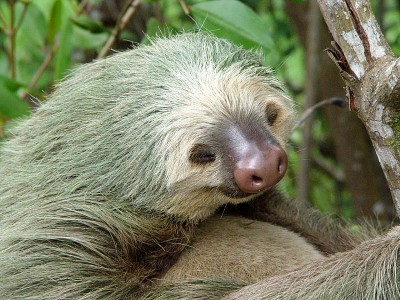
Whenever the word “enchanting” is used, there is something, well, enchanting about it. Maybe it’s just semantics, but there is definitely a stigma attached to that word. For me at least, it’s worth an investigation.
Drifting around Twitter-ville recently, I stumbled across this intriguing word. My predictability took over, and I followed the link to Velvet Escape’s post about the crowning jewel of Costa Rica’s ecological legacy, Tortuguero National Park. However brief as this article was, “enchanting” was only the start.
A maze of canals, estuaries, and lagoons are surrounded by the dense rainforests along the Caribbean; a combination that put Costa Rica on the map. Visitors to the park can take hike and boat tours through the waterways to get to the more intimate areas of the park. If you’re going by boat, expect canopy-covered canals through a wonderland of animal life (monkeys, tapirs, and sloths . . . need I say more?). If you choose to hike — opt for the guided night hike during turtle nesting season (tortuguero literally means “region of turtles”).
All these possibilities send my imagination reeling. Looks like I’ve been enchanted, yet again.
The post Costa Rica’s Enchanting Tortuguero National Park appeared first on The Expeditioner Travel Site.
]]>The post Can You Really See The Best Of Costa Rica In 8 Days? appeared first on The Expeditioner Travel Site.
]]>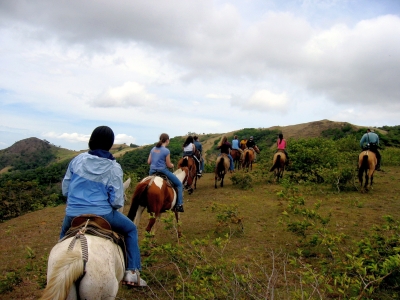
Probably not, but you can make a valiant effort and try, so long as that nasty sunburn doesn’t totally incapacitate you, you survive that skull-crushing fall from the Class IV rapids, and you don’t react too badly from that orange-kneed tarantula bite (actually the venom is unlikely to kill you — more like getting stung by a bee, a bee that injects their victim with liquefying venom).
As the NYT points out, “twenty-seven percent of Costa Rica’s land area is devoted to national parks and reserves, one of the highest percentages for any country.” So it’s unlikely you’ll ever be far from someplace where you can enjoy a different aspect of the outdoors, be it via beach, river, or eco-park. It’s no surprise that Rica is Central America’s most popular destination, with an estimated 1.9 million visitors in 2007 alone.
“The larán Mountains northwest of San José, Costa Rica’s capital, Monteverde is a Disneyland for eco-tourists,” containing such far-flung enterprises as nature tours, private zoos, and a fair-trade coffee plantation. There are also thousands of plant, bird, and animal species to see that call the mountains home. Doesn’t this make you feel bad for those people who wasted their vacation-time in Cancun this Spring ?
The post Can You Really See The Best Of Costa Rica In 8 Days? appeared first on The Expeditioner Travel Site.
]]>The post Looking For A Relaxing Trip? Avoid Costa Rica appeared first on The Expeditioner Travel Site.
]]>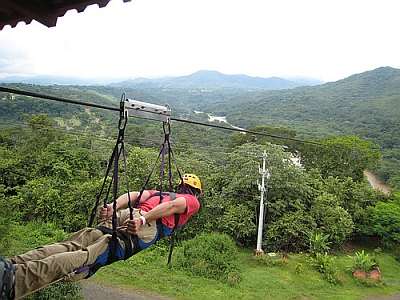
Maybe being named #5 on the Top 10 Eco-Friendly Countries list helped a bit, but Costa Rica is now known as one of the world’s best places to visit for an active trip. From zip-lining, horseback riding, extreme tubing (dude!), hiking, and maybe even a little rappelling for good measure, Costa Rica offers a huge array for one to endanger their life and get an extreme adrenaline rush, all at the same time.
Now that I have my health insurance all lined up and have little concern for my personal safety, when’s the best time to go and bungee jump into that volcanic crater, you ask? Well, according to Costa Rica itself, temperatures vary little throughout the year, so you’re best bet is to try to aim for one of the dry seasons: December – February (cool but clear) and March – April (hot but clear). Actually, the Rica looks amazing and I can’t wait to go one day soon. Now where did I pack away all of my skydiving gear . . . ?
The post Looking For A Relaxing Trip? Avoid Costa Rica appeared first on The Expeditioner Travel Site.
]]>